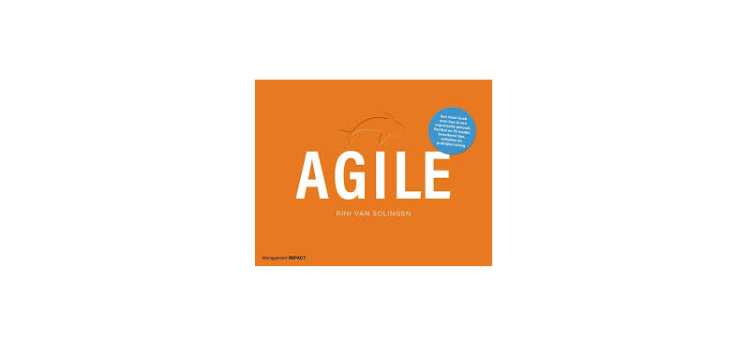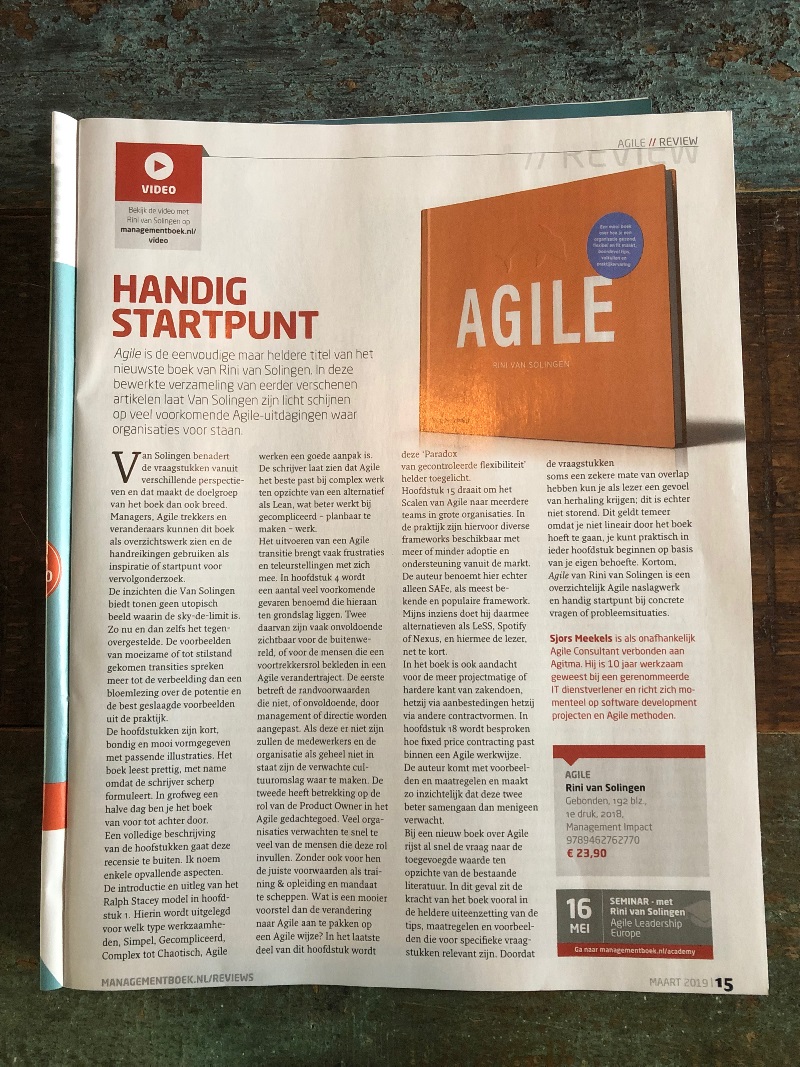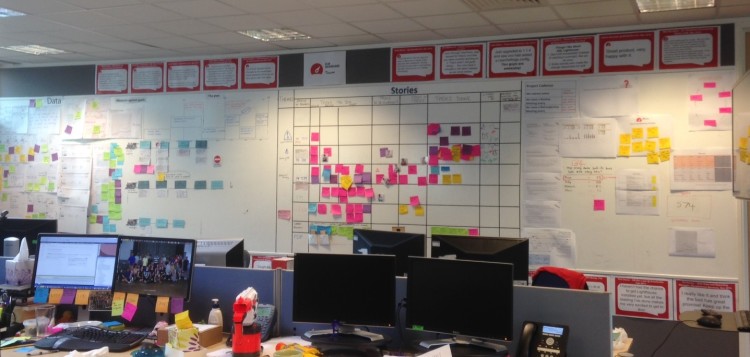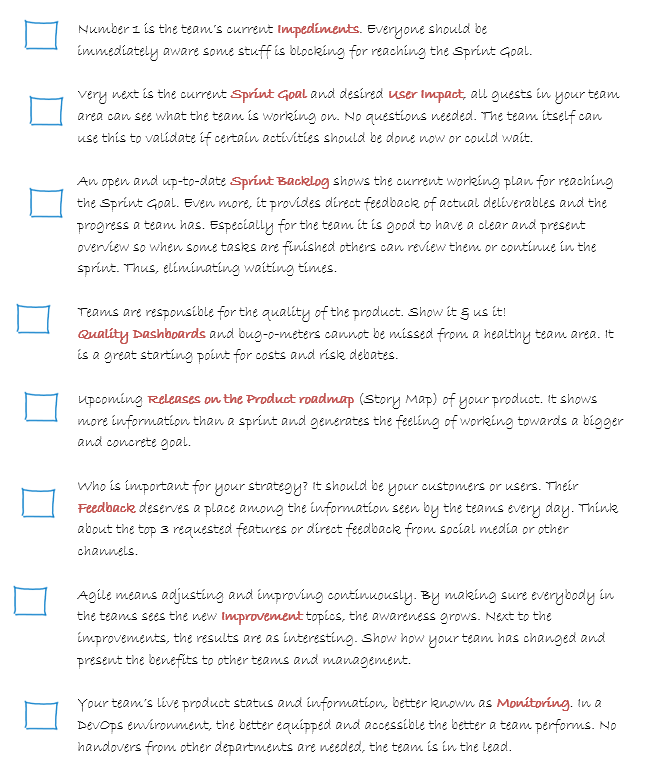
Agile – Rini van Solingen
“Agile” is de eenvoudige maar heldere titel van het nieuwste boek van Rini van Solingen. In deze bewerkte verzameling van eerder verschenen artikelen laat Van Solingen zijn licht schijnen op veel voorkomende Agile-uitdagingen waar organisaties voor staan. Vanuit verschillende perspectieven benadert hij de vraagstukken en dat maakt de doelgroep van het boek dan ook breed.
Managers, Agile trekkers en veranderaars kunnen dit boek als overzichtswerk zien en de handreikingen gebruiken als inspiratie of startpunt voor vervolgonderzoek.
Rini van Solingen is geen onbekende auteur in het Agile werkveld. Eerdere publicaties van hem zijn – naast zijn verschenen artikelen – onder andere: “De kracht van SCRUM” en “De Bijenherder”. In zijn nieuwste werk “Agile” verbindt hij eerder verschenen artikelen met elkaar tot één geheel. In twintig hoofdstukken neemt hij de lezer mee in zijn praktijkervaringen en observaties die hij in de laatste 9 jaar heeft opgedaan. De inzichten die hij biedt tonen geen utopisch beeld waarin de sky-de-limit is. Zo nu en dan zelfs het tegenovergestelde. De voorbeelden van moeizame of tot stilstand gekomen transities spreken meer tot de verbeelding dan een bloemlezing over de potentie en de best geslaagde voorbeelden uit de praktijk.

De hoofdstukken zijn kort, bondig en mooi vormgegeven met passende illustraties. Het boek leest prettig, met name omdat de schrijver scherp formuleert. In grofweg een halve dag ben je het boek van voor tot achter door.
Inhoudsopgave:
1. Het waarom, wat, wanneer en hoe van agile
2. Gaat het de juiste kant op?
3. Wendbaar door afmaken
4. Gevaren van agile
5. Scrum of agile?
6 Is agile haastwerk?
7. Agile transformaties
8. Valkuilen van agile transformaties
9. Agile cultuur
10. Agile leiderschap
11. Agile besturing en structuur
12. Product Owner valkuilen
13. Kwaliteit door autonomie
14. Hyperproductieve agile teams
15. Agile op grote schaal
16. Agile PI Planning
17. Agile opdrachtgeverschap
18. Agile en fixed-price
19. Automatiseren van herhalend werk
20. Agile schatten met Planning Poker
Een volledige beschrijving van de hoofstukken gaat deze recensie te buiten. Ik noem enkele opvallende aspecten.
De introductie en uitleg van het Ralph Stacey model in hoofdstuk 1. Hierin wordt uitgelegd voor welke type werkzaamheden, Simpel, Gecompliceerd, Complex tot Chaotisch, Agile werken een goede aanpak is. De schrijver laat zien dat Agile het beste past bij gecompliceerd werk ten opzichte van een alternatief als Lean, wat beter werkt bij gecompliceerd – planbaar te maken – werk.
Het uitvoeren van een Agile transitie brengt vaak frustraties en teleurstellingen met zich mee. In hoofdstuk 4 wordt een aantal veel voorkomende gevaren benoemt die hieraan ten grondslag liggen. Twee daarvan zijn voorkomend maar vaak onvoldoende zichtbaar voor de buitenwereld, of de mensen die een voortrekkersrol bekleden in een Agile verandertraject. De eerste betreft de randvoorwaarden die niet, of onvoldoende, door management of directie worden aangepast. Als deze er niet zijn zullen de medewerkers en de organisatie als geheel niet in staat zijn de verwachte cultuuromslag waar te maken. De tweede heeft betrekking op de rol van de Product Owner in het Agile gedachtegoed. Veel organisaties verwachten te snel te veel van de mensen die deze rol invullen. Zonder ook voor hen de juiste voorwaarden als training & opleiding en mandaat te scheppen. Wat is een mooier voorstel dan de verandering naar Agile aan te pakken op een Agile wijze? In het laatste deel van dit hoofdstuk wordt deze “Paradox van gecontroleerde flexibiliteit” helder toegelicht.
Hoofdstuk 15 draait om het Scalen van Agile naar meerdere teams in grote organisaties. In de praktijk zijn hiervoor diverse frameworks beschikbaar met meer of minder adoptie en ondersteuning vanuit de markt. De auteur benoemt hier echter alleen SAFe, als meest bekende en populaire framework. Mijns inziens doet hij daarmee alternatieven als LeSS, Spotify of Nexus, en hiermee de lezer, net te kort.
In het boek is ook aandacht voor de meer projectmatige of hardere kant van zakendoen, hetzij via aanbestedingen hetzij via andere contractvormen. In hoofdstuk 18 wordt besproken hoe fixed price contracting past binnen een Agile werkwijze. De auteur komt met voorbeelden en maatregelen en maak zo inzichtelijk dat deze twee beter samengaan dan menigeen verwacht.
Conclusie
Bij een nieuw boek over Agile rijst al snel de vraag naar de toegevoegde waarde ten opzichte van de bestaande literatuur. In dit geval zit de kracht van het boek vooral in de heldere uiteenzetting van de tips, maatregelen en voorbeelden die voor specifiek vraagstukken relevant zijn. Doordat de vraagstukken soms een zekere mate van overlap kennen kun je als lezer een gevoel van herhaling krijgen; dit is echter niet storend. Dit geldt temeer omdat je niet lineair door het boek hoeft te gaan, je kunt praktisch in ieder hoofdstuk beginnen op basis van je eigen behoefte. Kortom, een overzichtelijk Agile naslagwerk en handig startpunt bij concrete vragen of probleemsituaties.
Over deze recensie
Deze boekrecensie is tevens verschenen op www.managementboek.nl.
Cheers,
– Sjors Meekels
Filled Under: agile,agile projectmanagement,book review,scrum Posted on: 12 January 2019






